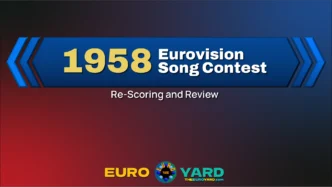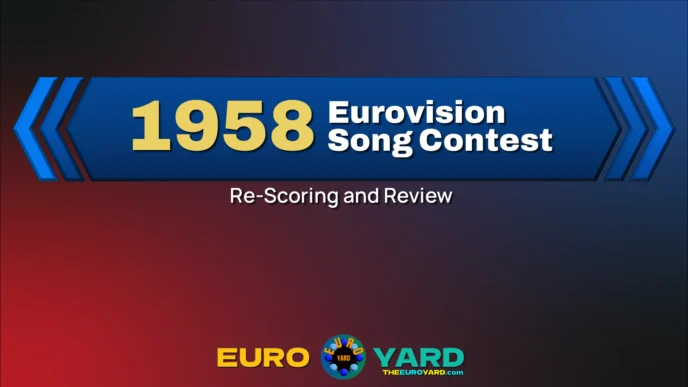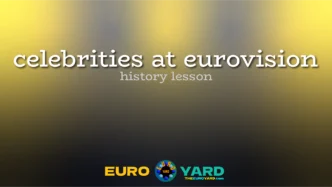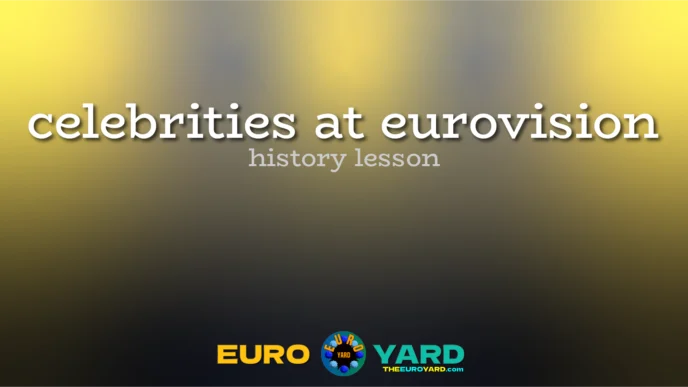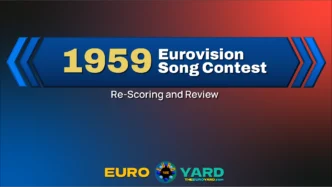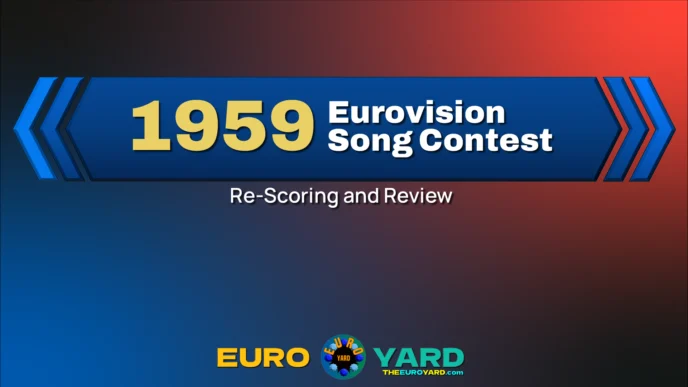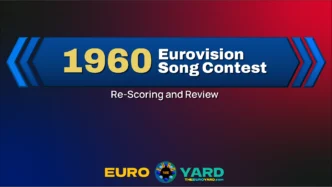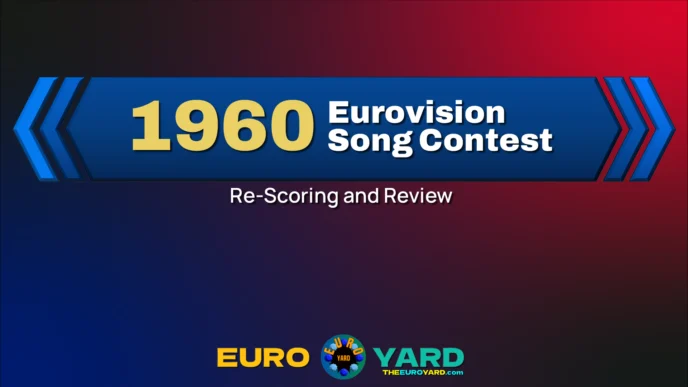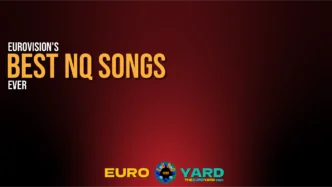Just a day or two ago, the official look at the Eurovision stage for 2024 was revealed by the contest organizers. What we saw was a visually stunning and bright area for the 37 acts to shine, and one of them will be handed a trophy there.
As if I need to say this, the Eurovision stage has not always been this way. When talking about something that started in 1956, when Europe was only about a decade removed from a terrible war, a significant amount of evolution has taken place. How we got from austerity to a gigantic concert venue was far from an overnight development, and maybe more recent than you think.
The Euro Yard takes you through the transformation of the Eurovision stage from its basic form to the grand spectacles of 2024 and beyond. Also identified are several key years in which the quality of the stage took a major leap forward.
We have linked to a number of sources provided by others where you can see the stages for yourself, if you so choose. There’s also a great tool called Google.
The Eurovision Stage: The 1950s
| Year | ESC | Host | Stage Description |
| 1956 | 1st | Lugano, CH | Basic auditorium setting with orchestra on one side and the singer on the other, who was surrounded by flowers – backdrop during each song was either a curtain or a cartoon mural representing the performing country |
| 1957 | 2nd | Frankfurt, DE | Stairs led performers onto the small performance area from behind the curtain – the orchestra was to the right of the singers and the scoreboard was to the left – a small mural sat behind the singers |
| 1958 | 3rd | Hilversum, NL | Followed a similar format to 1957, but also with a different color scheme – behind the singers were what resembled windows with flowered drapes |
| 1959 | 4th | Cannes, FR | KEY YEAR – This was the first appreciable leap forward in design for the Eurovision stage – there were three rotating platforms and the orchestra sat in front of them down the stairs – each platform was like a turnstile, revealing artwork which represented each country, and the singers would perform in front of them – the scoreboard was off to the left of the stage |
The 1960s
| Year | ESC | Host | Stage Description |
| 1960 | 5th | London, UK | The staging had some unique flourishes, like a different backdrop for every act (not always a mural or picture, in some acts they were artistic shapes), with the orchestra on one side of the curtain and the scoreboard on the other |
| 1961 | 6th | Cannes, FR | France stepped up again with the first real set Eurovision had, taking it up a notch from their 1959 host duties – there was a large balcony surrounded by stairs dominating the stage |
| 1962 | 7th | Luxembourg, LU | The very large orchestra was off to the side of the stage again, which was more of a revamped edition of what the UK did in 1960, or even what The Netherlands did in 1958 |
| 1963 | 8th | London, UK | KEY YEAR – This was the most ambitious staging of the contest yet by far – Having been done at the BBC studios, every single song was staged differently, from the setting, to props, to camera angles – the performances were done in a different studio than the audience to allow for greater staging flexibility, and so for the first time, it came across as a real, certified television production rather than a concert at an auditorium |
| 1964 | 9th | Copenhagen, DK | Less grand than the UK’s 1963 hosting job, Denmark featured a far simpler stage with a gold curtain, artwork, and a set of stairs for singers to descend to the microphone |
| 1965 | 10th | Naples, IT | The orchestra was off to the side of the stage at this auditorium, but the stage backdrop was a very, very simple blow-up of the Eurovision logo |
| 1966 | 11th | Luxembourg, LU | This was another somewhat updated version of 1958, 1960, and 1962, with a slightly more active and artistic set, but stairs leading the singers from backstage |
| 1967 | 12th | Vienna, AT | Definitely a bit different from what was done before with (unusual) rotating mirrors behind the singers, but not in any way was it out of line with what was seen before |
| 1968 | 13th | London, UK | KEY YEAR – Hosting the show again, the UK modernized the set a bit more – not only was every singer shown backstage before going on, but an image of the singer was projected on a screen as they look the stage, and the background behind the Eurovision logo changed colors – this was the first usage of any electronic graphic elements in the staging |
| 1969 | 14th | Madrid, ES | Spain had a more wide-open stage than in many years past, with a statue in the back – having some abstract art in the background is an element that would last for decades |
The 1970s
| Year | ESC | Host | Stage Description |
| 1970 | 15th | Amsterdam, NL | The Dutch dialed up the abstract art with moving shapes behind the singers, and a color-changing background – otherwise, the era of big curtains on stage was over by this point |
| 1971 | 16th | Dublin, IE | Quite similar to the staging in 1970, just different abstract pieces in the background |
| 1972 | 17th | Edinburgh, UK | Colorful lights on the stage and moving images off to the side, though it was perhaps a smaller performing area than in some recent years past |
| 1973 | 18th | Luxembourg, LU | Maybe one of the more unique stages ever, the orchestra was behind the singers in tiers, but Luxembourg also gave us moving and changing colors – the backing musicians and vocalists were on risers behind the lead singer |
| 1974 | 19th | Brighton, UK | The whole stage in 1974 appeared to be abstract art, surrounded by lights and with a shimmering curtain behind it – the orchestra was in front, in between the stage and the audience – the lighting would change colors for each performance |
| 1975 | 20th | Stockholm, SE | Sweden went a little less robust in their first time hosting, yes to the abstract art and big performing area, but it was not an overly colorful set |
| 1976 | 21st | The Hague, NL | This set went back to more of what we expected from 1970s Eurovision stages, with colorful abstract art in the background that changed position during each number |
| 1977 | 22nd | London, UK | Absolutely the most colorful set to this point, the orchestra was behind the main stage, which featured a bright, lit-up (color-changing) rotating platform |
| 1978 | 23rd | Paris, FR | Another unique setup, with the orchestra on stage behind the singers on a rotating platform – curtains surrounded the stage, which featured some color but was otherwise kind of dark |
| 1979 | 24th | Jerusalem, IL | This was a big year for the elevation of postcards, but not so much the stage: The abstract art made it very similar to what we saw in most of the 1970s |
The 1980s
| Year | ESC | Host | Stage Description |
| 1980 | 25th | The Hague, NL | The 1980s picked up where the 1970s left off, and was mostly an updated version of what the Dutch did when they hosted in 1970 and 1976 |
| 1981 | 26th | Dublin, IE | Not far off of the Eurovision stages of the period, with abstract art in the back which looked like large illuminated circles which changed color, and a stair-laden stage |
| 1982 | 27th | Harrogate, UK | A smaller performing area than the previous year, but this stage had the feel of a game show set – that is perhaps the best and only way to describe it |
| 1983 | 28th | Munich, DE | The whole backdrop of the stage was dotted with lights, but other than that, it was quite plain relative to other stages in the early 1980s – the orchestra was in the pit below |
| 1984 | 29th | Luxembourg, LU | Back to the abstract art that moves and changes colors, Luxembourg was going for something more along the lines of “Tron” – given how trippy their postcards were, this is not that surprising |
| 1985 | 30th | Gothenburg, SE | KEY YEAR – The third era of Eurovision stage design began here as Sweden pushed the concept considerably – The emphasis on neon lights and a more modern feel took off, and yes, while there was more abstract art to be seen, this was the brightest and most exciting set yet |
| 1986 | 31st | Bergen, NO | Norway made the stage perhaps less modern, but it was clear that more elaborate stage design was in order – the backdrop were large, illuminated shapes that look like ice crystals – in a real throwback, there were steps leading from backstage |
| 1987 | 32nd | Brussels, BE | The neon lights were back and Belgium’s set was expansive – it was a mix of Luxembourg in 1984 and Norway in 1986, without the large icicles |
| 1988 | 33rd | Dublin, IE | With more neon lights, the trend towards darker stages was on, and kind of like Luxembourg in 1984, Dublin was living its “Tron” fantasy this year – this was also the first year with an electronic scoreboard, meaning a large screen replaced the physical board |
| 1989 | 34th | Lausanne, CH | It looked like a smaller stage area to be sure, and maybe not as elaborate as some of what the years past had in store, but the neon lights were out in force, including on a pyramid/trapezoid thing in the back of the stage |
The 1990s
| Year | ESC | Host | Stage Description |
| 1990 | 35th | Zagreb, YU | Yugoslavia’s only hosted show kept in line with the stages of the day, but their screens were much larger, showing the performers during their numbers as well as the scores |
| 1991 | 36th | Rome, IT | More big screens, but this could have also been the set to a Broadway show as there was a city backdrop all around – the orchestra was in the back of the stage |
| 1992 | 37th | Malmö, SE | Lots of colorful lights coming from the rafters, but the feature of this stage – perhaps the only one – was the large Viking ship mast in the back |
| 1993 | 38th | Millstreet, IE | A big, lit-up performance area with a large space in between the crowd and the stage to allow for the cameras to roam – orchestra was off to the back side |
| 1994 | 39th | Dublin, IE | Kind of a revamped idea of what Italy did in 1991, not as bright of a stage, but more colorful |
| 1995 | 40th | Dublin, IE | The back of the stage looked like a shimmering waterfall, although it did not remain the same color, and the orchestra was back and to the left of the performers |
| 1996 | 41st | Oslo, NO | KEY YEAR – This was not an era-ending year, but what made this year unique was the use of virtual reality for the first time in the scoreboard, a massive advance in the staging – the stage was smaller than in years past but had a 90s dance club vibe |
| 1997 | 42nd | Dublin, IE | Certainly a little more ornate than in years past, the color-changing stage was surrounded by large columns with small monitors on them, and yes, the lighting was dark overall |
| 1998 | 43rd | Birmingham, UK | The last year with an orchestra, which was off to the right side – the abstract makes another appearance here with the set design, the shapes of which would not be easy for a layman to describe |
| 1999 | 44th | Jerusalem, IL | KEY YEAR – This was the first year since 1968 where the full background of the stage showed projected images – the orchestra is gone for good, which allowed more room for the stage and crowd, the latter of which was becoming more boisterous over time – a colorful background featured spinning objects and an expanding set of rays of light in front of the big screen |
The Eurovision Stage: The 2000s
| Year | ESC | Host | Stage Description |
| 2000 | 45th | Stockholm, SE | KEY YEAR – This was an extension of what Israel did in 1999, going all-in on the multiple video screens behind and around the stage, and otherwise modernizing the look of the contest with a very colorful display |
| 2001 | 46th | Copenhagen, DK | Denmark continued the trend of the past few years with big staging and graphic visuals, putting this contest in one of the most massive arenas it has ever seen |
| 2002 | 47th | Tallinn, EE | Estonia went smaller in 2002, and the abstract art was back, but this stage featured a runway for the performers that looped around like an arm – the background was otherwise all screens |
| 2003 | 48th | Riga, LV | Latvia did not keep up the trend of the big projection screens in 2003, but they would of course be back – it was most similar to a bigger and slightly brighter version of what Ireland did in 1997 – first time that the stage floor incorporated a visual screen |
| 2004 | 49th | Istanbul, TR | Turkey’s stage featured screens all around and a large performance area, which had platforms in several spots – even though the era of abstract art all day, every day was over by now, it wasn’t completely gone by 2004 |
| 2005 | 50th | Kyiv, UA | Ukraine’s stage was visually appealing, with even the platforms around the stage featuring LED lights that changed with each performance |
| 2006 | 51st | Athens, GR | This stage had what appeared to be staircases (or what resembles them) all around with two video screens on each side – by the way, these “staircases” were video screens themselves |
| 2007 | 52nd | Helsinki, FI | KEY YEAR – Once again the floor of the stage itself was also an LED screen, an unbroken trend that continues into the modern day – otherwise, the stage itself was relatively in-line with others from past years, and the stage was surrounded by video screens |
| 2008 | 53rd | Belgrade, RS | Continued the trend started by Finland, but on an even larger scale – the whole stage was enveloped by a large video screen, and the floor was a screen as well |
| 2009 | 54th | Moscow, RU | By far the biggest sensory spectacle to that point in Eurovision history, the screen behind the stage was massive, the floor was a screen, and there were moving shapes above the stage that were also screens |
The 2010s
| Year | ESC | Host | Stage Description |
| 2010 | 55th | Oslo, NO | Norway went a little less all-out in 2010, and there was no floor or backstage screen, but the LED lights were all over nevertheless – the stage had a transparent floor |
| 2011 | 56th | Düsseldorf, DE | The big LED screen was back in 2011, in front of a large, circular performance area which had a long, curved runway – the setup was comparable to something you might see in the 2020s |
| 2012 | 57th | Baku, AZ | Azerbaijan’s fire theme was apparent, and the screens behind the stage were large, abstract shapes – two long runways extended from the stage, and a handful of fans surrounded it on three sides |
| 2013 | 58th | Malmö, SE | The icicle shapes above the stage and on the sides were a bit of a throwback to Norway 1986, but nothing about this was the same as then – this was a fairly contemporary stage for this era |
| 2014 | 59th | Copenhagen, DK | The LED floor was back, and the stage was surrounded by what looked like an illuminated cube: this cube, backed by another large LED screen, sat on a diamond-shaped stage, and the cube itself kind of looked like storage containers (which fits because the site of the venue used to be a shipyard) |
| 2015 | 60th | Vienna, AT | Large pipes/cylinders surrounded the stage from the sides and above, and no shock that there was an LED floor and background |
| 2016 | 61st | Stockholm, SE | The green room sat to the back of the arena, while the stage itself – the stage floor had no LED screen, but the back certainly did – a very contemporary stage yet again |
| 2017 | 62nd | Kyiv, UA | A large artistic form sat over the stage, shaped like a distorted arch, which also happened to be a series of LED screens |
| 2018 | 63rd | Lisbon, PT | This stage had kind of the same idea as Ukraine in 2017, but instead of one big, distorted arch above the stage, it was a few smaller and not very distorted ones |
| 2019 | 64th | Tel Aviv, IL | One of the most modern and visually-stunning Eurovision stages ever, triangles were a dominant theme on stage, in the ceiling, and on the performers’ walkways, and of course, the main stage was backed by a large screen |
The 2020s
| Year | ESC | Host | Stage Description |
| 2021 | 65th | Rotterdam, NL | The green room was up against the stage, which featured a large performance area and a centered runway – a large LED screen sat behind it |
| 2022 | 66th | Turin, IT | An illuminated, color-changing semicircle sat at the back of the stage (the “kinetic sun”) – the front of the stage featured a waterfall, while there were also walkways extending around it – the floor and area behind the semicircle also illuminated |
| 2023 | 67th | Liverpool, UK | A large LED backdrop, a stage surrounded by lights, and an LED floor with a performance area that extends out like a runway – the green room was towards the back of the arena |
| 2024 | 68th | Malmö, SE | A large cross in the center of the arena, backed by a large LED screen – the floor itself and the cubes floating above it are also LED screens – the green room returned backstage |
| 2025 | 69th | Switzerland TBD | TBD |
The Eurovision Stage: Eras
| 1st Era | 1956-1967 | Smaller stages, curtains, less elaborate set designs for the most part |
| 2nd Era | 1968-1984 | No or few curtains on stage, larger performing areas, abstract art, and the introduction of various colors and greater visuals to the backdrop |
| 3rd Era | 1985-1998 | More elaborate and modern stage design and bright neon lights offsetting dark stages, and the eventual introduction of the graphical scoreboard |
| 4th Era | 1999-2006 | Orchestra is gone, stages beginning to feature large projection screens in the back as part of the staging |
| 5th Era | 2007-Present | Background of stage and the stage itself are LED video screens, which become a major factor in the act’s performance |


